Digital Shadows: Managing a Project on Technology's Business Impact
VerifiedAdded on 2024/05/20
|22
|5099
|415
Report
AI Summary
This report analyzes the impact of digital technology on Digital Shadows, a UK-based startup, focusing on how the company manages digital risks. It includes a project management plan with aims, objectives, a work breakdown structure, and a Gantt chart to schedule research activities. The report also presents small-scale research using qualitative and quantitative methods to achieve the project plan's objectives. It examines the advantages and disadvantages of digital technologies, how digital transformation affects individuals and groups within the company, and how these technologies influence perceptions of employees, leaders, and managers. Additionally, the report identifies challenges posed by digital revolutions and concludes with recommendations and a reflection on the learning experience during project planning, assessing the effectiveness of digital technologies for organizations.
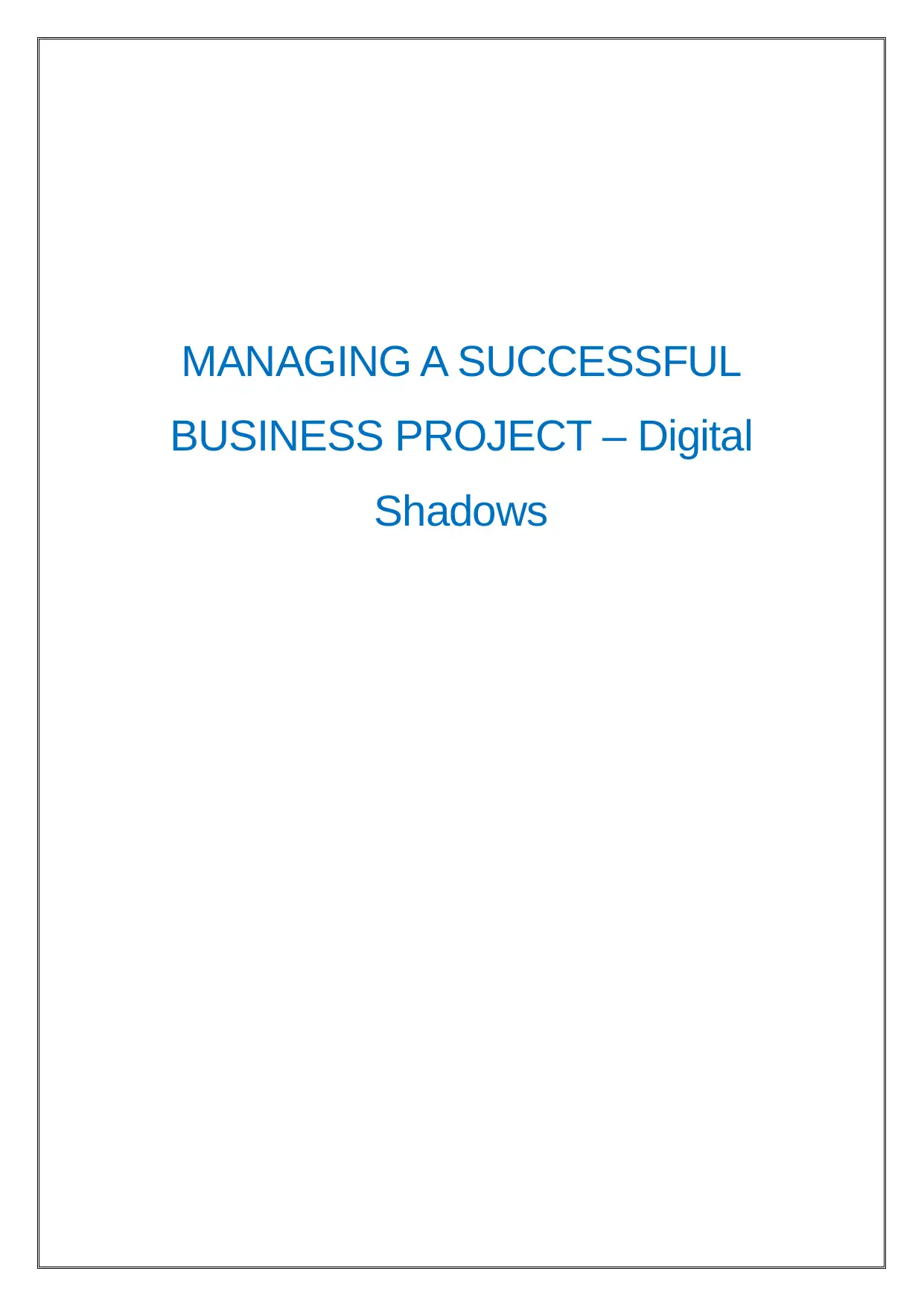
MANAGING A SUCCESSFUL
BUSINESS PROJECT – Digital
Shadows
BUSINESS PROJECT – Digital
Shadows
Paraphrase This Document
Need a fresh take? Get an instant paraphrase of this document with our AI Paraphraser
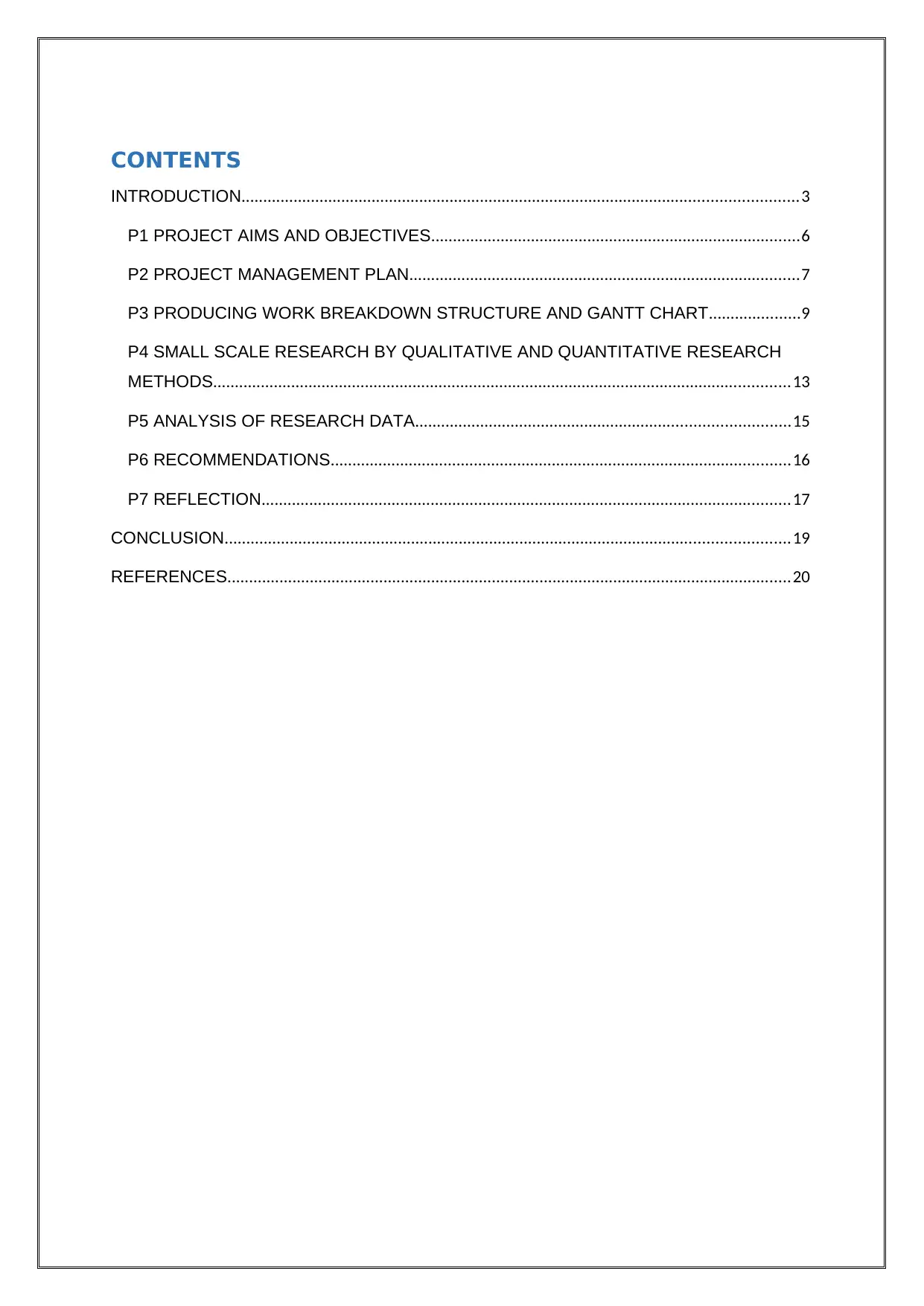
CONTENTS
INTRODUCTION................................................................................................................................3
P1 PROJECT AIMS AND OBJECTIVES.....................................................................................6
P2 PROJECT MANAGEMENT PLAN..........................................................................................7
P3 PRODUCING WORK BREAKDOWN STRUCTURE AND GANTT CHART.....................9
P4 SMALL SCALE RESEARCH BY QUALITATIVE AND QUANTITATIVE RESEARCH
METHODS.....................................................................................................................................13
P5 ANALYSIS OF RESEARCH DATA......................................................................................15
P6 RECOMMENDATIONS..........................................................................................................16
P7 REFLECTION..........................................................................................................................17
CONCLUSION..................................................................................................................................19
REFERENCES..................................................................................................................................20
INTRODUCTION................................................................................................................................3
P1 PROJECT AIMS AND OBJECTIVES.....................................................................................6
P2 PROJECT MANAGEMENT PLAN..........................................................................................7
P3 PRODUCING WORK BREAKDOWN STRUCTURE AND GANTT CHART.....................9
P4 SMALL SCALE RESEARCH BY QUALITATIVE AND QUANTITATIVE RESEARCH
METHODS.....................................................................................................................................13
P5 ANALYSIS OF RESEARCH DATA......................................................................................15
P6 RECOMMENDATIONS..........................................................................................................16
P7 REFLECTION..........................................................................................................................17
CONCLUSION..................................................................................................................................19
REFERENCES..................................................................................................................................20
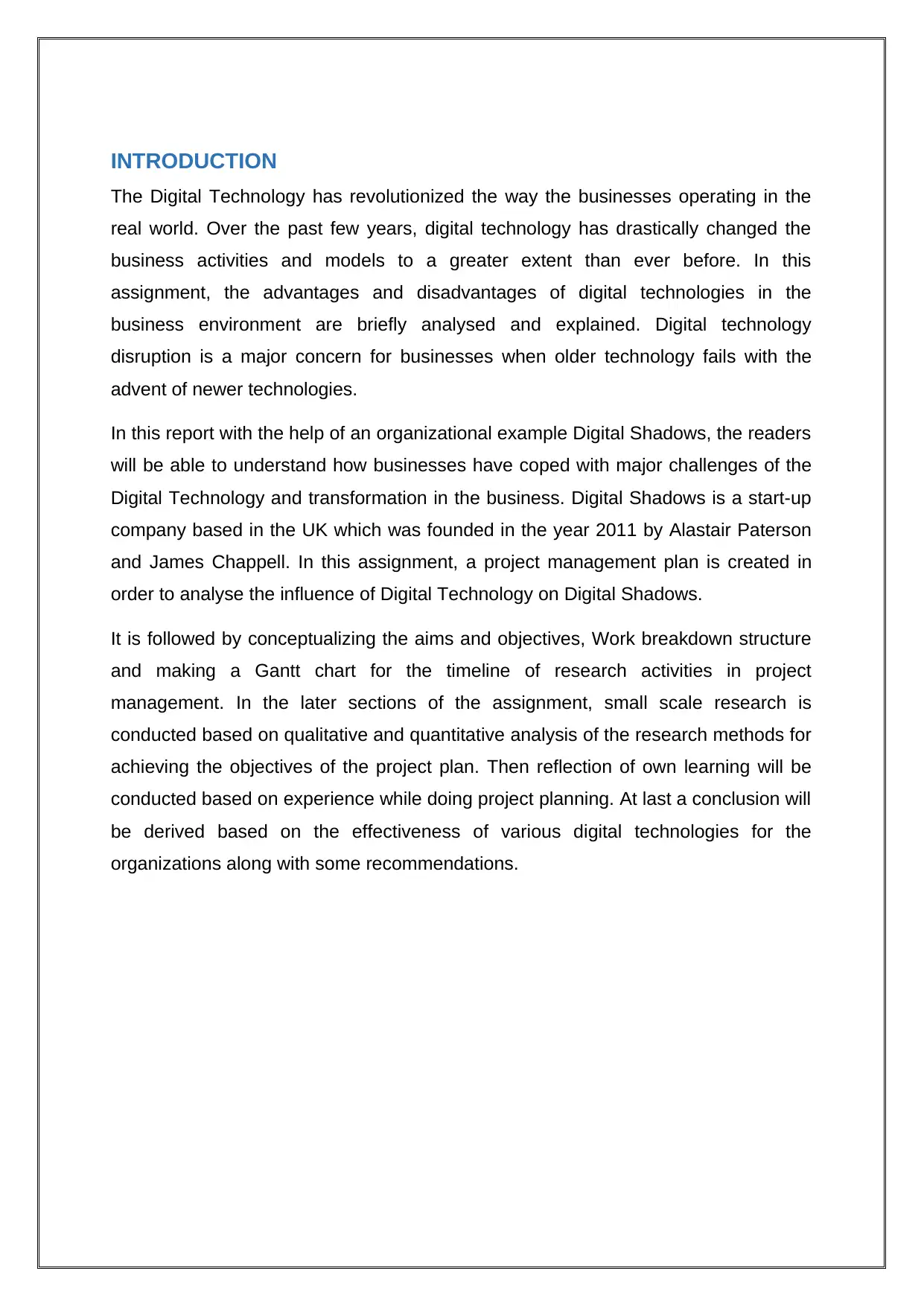
INTRODUCTION
The Digital Technology has revolutionized the way the businesses operating in the
real world. Over the past few years, digital technology has drastically changed the
business activities and models to a greater extent than ever before. In this
assignment, the advantages and disadvantages of digital technologies in the
business environment are briefly analysed and explained. Digital technology
disruption is a major concern for businesses when older technology fails with the
advent of newer technologies.
In this report with the help of an organizational example Digital Shadows, the readers
will be able to understand how businesses have coped with major challenges of the
Digital Technology and transformation in the business. Digital Shadows is a start-up
company based in the UK which was founded in the year 2011 by Alastair Paterson
and James Chappell. In this assignment, a project management plan is created in
order to analyse the influence of Digital Technology on Digital Shadows.
It is followed by conceptualizing the aims and objectives, Work breakdown structure
and making a Gantt chart for the timeline of research activities in project
management. In the later sections of the assignment, small scale research is
conducted based on qualitative and quantitative analysis of the research methods for
achieving the objectives of the project plan. Then reflection of own learning will be
conducted based on experience while doing project planning. At last a conclusion will
be derived based on the effectiveness of various digital technologies for the
organizations along with some recommendations.
The Digital Technology has revolutionized the way the businesses operating in the
real world. Over the past few years, digital technology has drastically changed the
business activities and models to a greater extent than ever before. In this
assignment, the advantages and disadvantages of digital technologies in the
business environment are briefly analysed and explained. Digital technology
disruption is a major concern for businesses when older technology fails with the
advent of newer technologies.
In this report with the help of an organizational example Digital Shadows, the readers
will be able to understand how businesses have coped with major challenges of the
Digital Technology and transformation in the business. Digital Shadows is a start-up
company based in the UK which was founded in the year 2011 by Alastair Paterson
and James Chappell. In this assignment, a project management plan is created in
order to analyse the influence of Digital Technology on Digital Shadows.
It is followed by conceptualizing the aims and objectives, Work breakdown structure
and making a Gantt chart for the timeline of research activities in project
management. In the later sections of the assignment, small scale research is
conducted based on qualitative and quantitative analysis of the research methods for
achieving the objectives of the project plan. Then reflection of own learning will be
conducted based on experience while doing project planning. At last a conclusion will
be derived based on the effectiveness of various digital technologies for the
organizations along with some recommendations.
⊘ This is a preview!⊘
Do you want full access?
Subscribe today to unlock all pages.

Trusted by 1+ million students worldwide
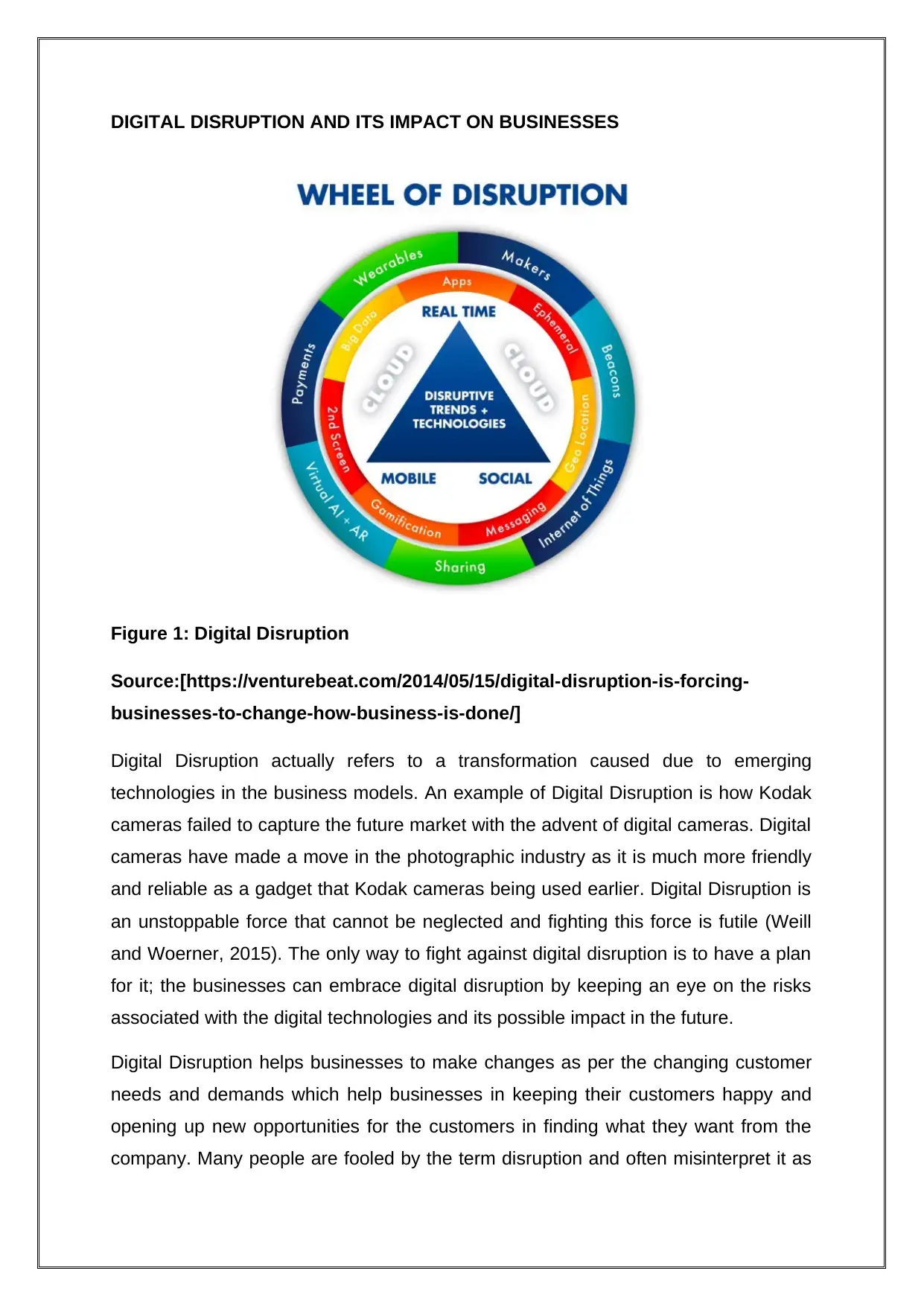
DIGITAL DISRUPTION AND ITS IMPACT ON BUSINESSES
Figure 1: Digital Disruption
Source:[https://venturebeat.com/2014/05/15/digital-disruption-is-forcing-
businesses-to-change-how-business-is-done/]
Digital Disruption actually refers to a transformation caused due to emerging
technologies in the business models. An example of Digital Disruption is how Kodak
cameras failed to capture the future market with the advent of digital cameras. Digital
cameras have made a move in the photographic industry as it is much more friendly
and reliable as a gadget that Kodak cameras being used earlier. Digital Disruption is
an unstoppable force that cannot be neglected and fighting this force is futile (Weill
and Woerner, 2015). The only way to fight against digital disruption is to have a plan
for it; the businesses can embrace digital disruption by keeping an eye on the risks
associated with the digital technologies and its possible impact in the future.
Digital Disruption helps businesses to make changes as per the changing customer
needs and demands which help businesses in keeping their customers happy and
opening up new opportunities for the customers in finding what they want from the
company. Many people are fooled by the term disruption and often misinterpret it as
Figure 1: Digital Disruption
Source:[https://venturebeat.com/2014/05/15/digital-disruption-is-forcing-
businesses-to-change-how-business-is-done/]
Digital Disruption actually refers to a transformation caused due to emerging
technologies in the business models. An example of Digital Disruption is how Kodak
cameras failed to capture the future market with the advent of digital cameras. Digital
cameras have made a move in the photographic industry as it is much more friendly
and reliable as a gadget that Kodak cameras being used earlier. Digital Disruption is
an unstoppable force that cannot be neglected and fighting this force is futile (Weill
and Woerner, 2015). The only way to fight against digital disruption is to have a plan
for it; the businesses can embrace digital disruption by keeping an eye on the risks
associated with the digital technologies and its possible impact in the future.
Digital Disruption helps businesses to make changes as per the changing customer
needs and demands which help businesses in keeping their customers happy and
opening up new opportunities for the customers in finding what they want from the
company. Many people are fooled by the term disruption and often misinterpret it as
Paraphrase This Document
Need a fresh take? Get an instant paraphrase of this document with our AI Paraphraser
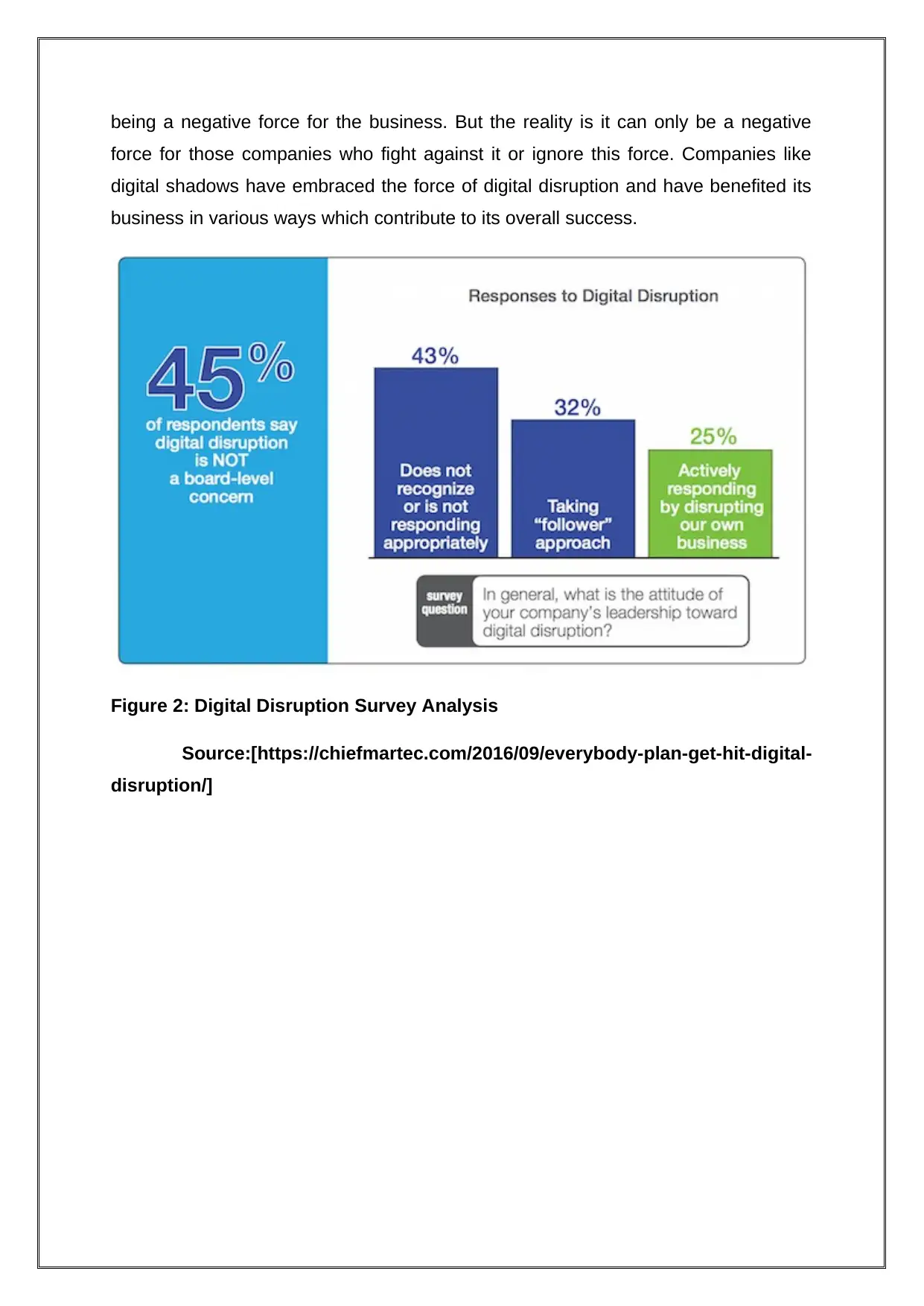
being a negative force for the business. But the reality is it can only be a negative
force for those companies who fight against it or ignore this force. Companies like
digital shadows have embraced the force of digital disruption and have benefited its
business in various ways which contribute to its overall success.
Figure 2: Digital Disruption Survey Analysis
Source:[https://chiefmartec.com/2016/09/everybody-plan-get-hit-digital-
disruption/]
force for those companies who fight against it or ignore this force. Companies like
digital shadows have embraced the force of digital disruption and have benefited its
business in various ways which contribute to its overall success.
Figure 2: Digital Disruption Survey Analysis
Source:[https://chiefmartec.com/2016/09/everybody-plan-get-hit-digital-
disruption/]
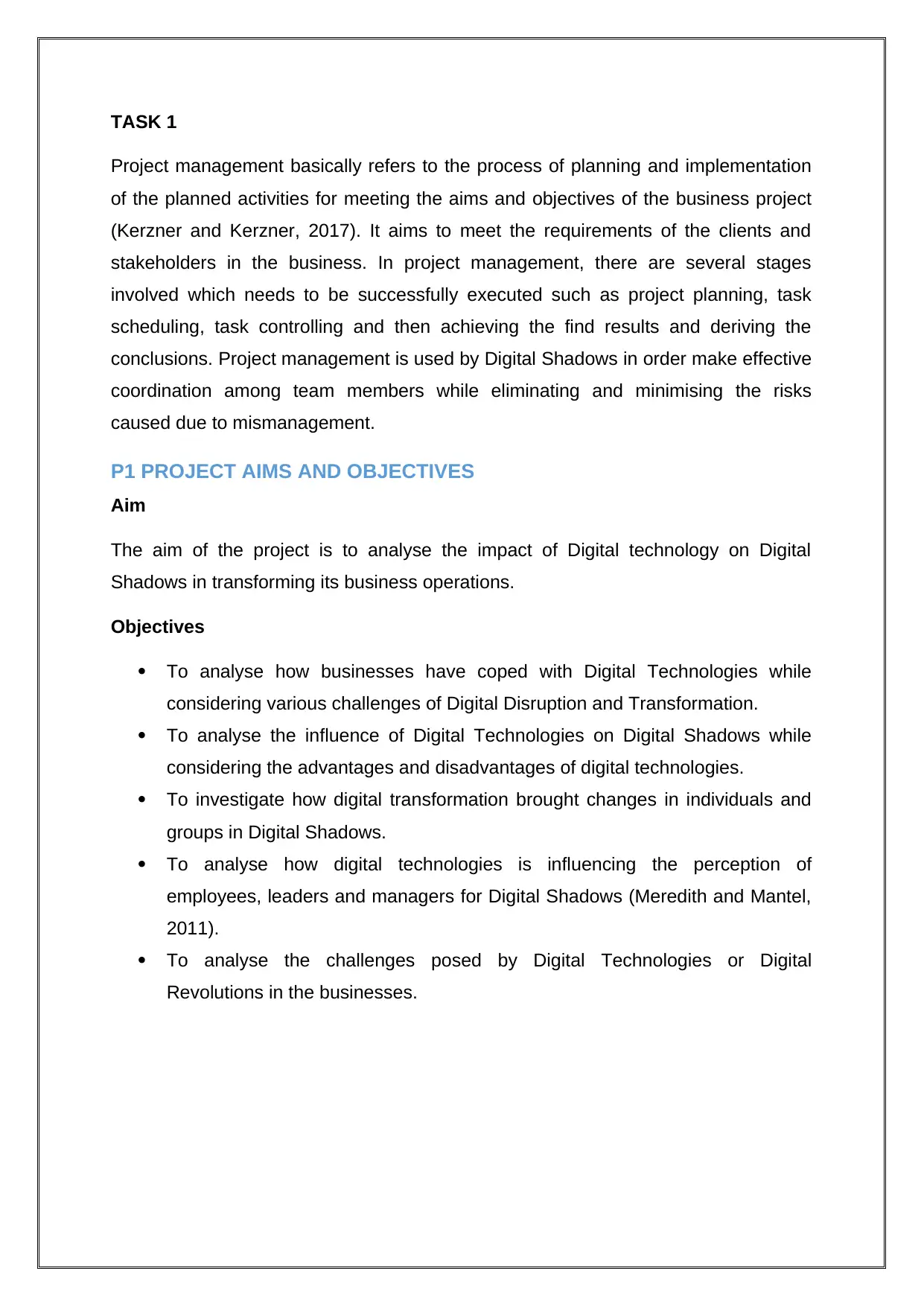
TASK 1
Project management basically refers to the process of planning and implementation
of the planned activities for meeting the aims and objectives of the business project
(Kerzner and Kerzner, 2017). It aims to meet the requirements of the clients and
stakeholders in the business. In project management, there are several stages
involved which needs to be successfully executed such as project planning, task
scheduling, task controlling and then achieving the find results and deriving the
conclusions. Project management is used by Digital Shadows in order make effective
coordination among team members while eliminating and minimising the risks
caused due to mismanagement.
P1 PROJECT AIMS AND OBJECTIVES
Aim
The aim of the project is to analyse the impact of Digital technology on Digital
Shadows in transforming its business operations.
Objectives
To analyse how businesses have coped with Digital Technologies while
considering various challenges of Digital Disruption and Transformation.
To analyse the influence of Digital Technologies on Digital Shadows while
considering the advantages and disadvantages of digital technologies.
To investigate how digital transformation brought changes in individuals and
groups in Digital Shadows.
To analyse how digital technologies is influencing the perception of
employees, leaders and managers for Digital Shadows (Meredith and Mantel,
2011).
To analyse the challenges posed by Digital Technologies or Digital
Revolutions in the businesses.
Project management basically refers to the process of planning and implementation
of the planned activities for meeting the aims and objectives of the business project
(Kerzner and Kerzner, 2017). It aims to meet the requirements of the clients and
stakeholders in the business. In project management, there are several stages
involved which needs to be successfully executed such as project planning, task
scheduling, task controlling and then achieving the find results and deriving the
conclusions. Project management is used by Digital Shadows in order make effective
coordination among team members while eliminating and minimising the risks
caused due to mismanagement.
P1 PROJECT AIMS AND OBJECTIVES
Aim
The aim of the project is to analyse the impact of Digital technology on Digital
Shadows in transforming its business operations.
Objectives
To analyse how businesses have coped with Digital Technologies while
considering various challenges of Digital Disruption and Transformation.
To analyse the influence of Digital Technologies on Digital Shadows while
considering the advantages and disadvantages of digital technologies.
To investigate how digital transformation brought changes in individuals and
groups in Digital Shadows.
To analyse how digital technologies is influencing the perception of
employees, leaders and managers for Digital Shadows (Meredith and Mantel,
2011).
To analyse the challenges posed by Digital Technologies or Digital
Revolutions in the businesses.
⊘ This is a preview!⊘
Do you want full access?
Subscribe today to unlock all pages.

Trusted by 1+ million students worldwide
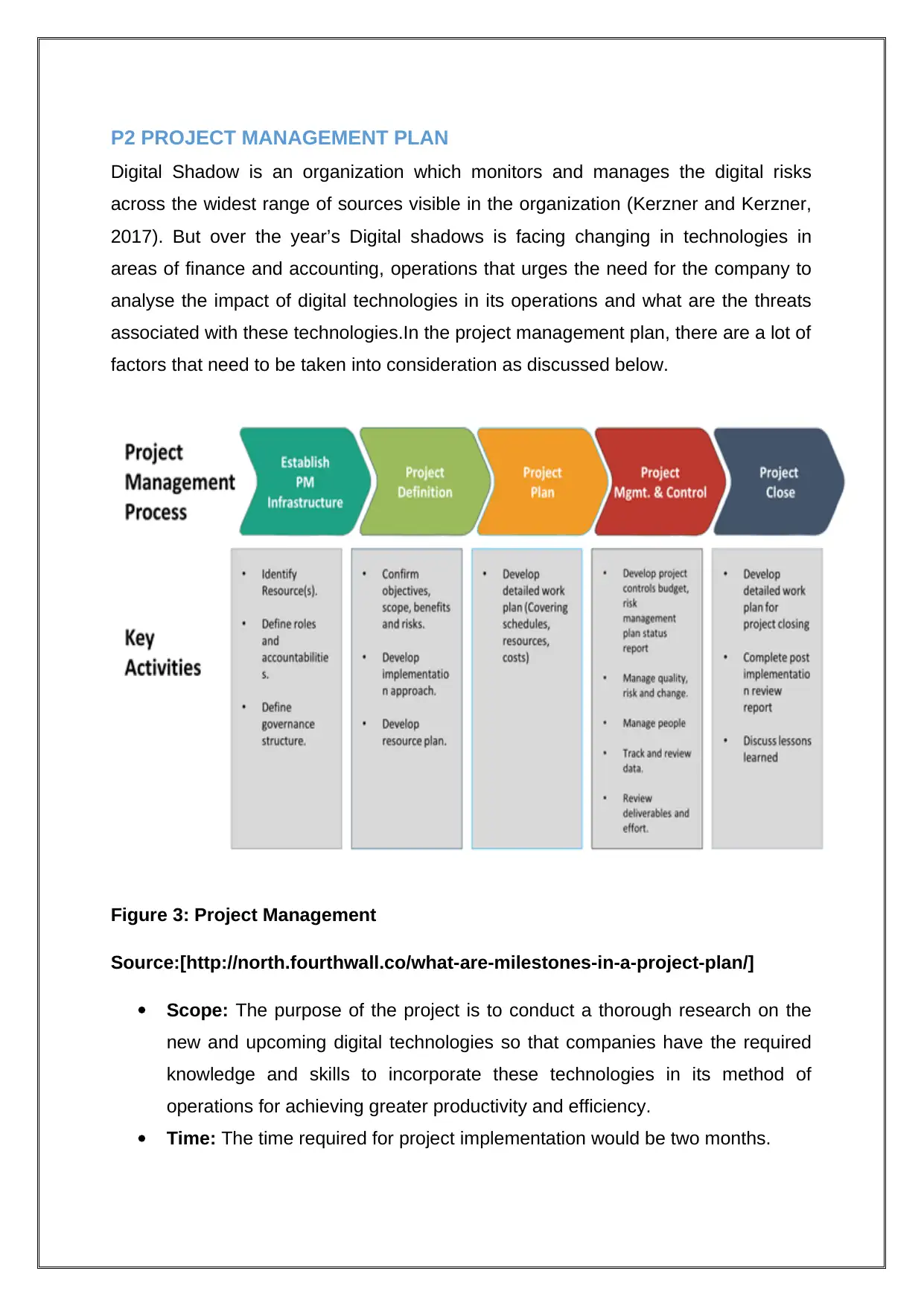
P2 PROJECT MANAGEMENT PLAN
Digital Shadow is an organization which monitors and manages the digital risks
across the widest range of sources visible in the organization (Kerzner and Kerzner,
2017). But over the year’s Digital shadows is facing changing in technologies in
areas of finance and accounting, operations that urges the need for the company to
analyse the impact of digital technologies in its operations and what are the threats
associated with these technologies.In the project management plan, there are a lot of
factors that need to be taken into consideration as discussed below.
Figure 3: Project Management
Source:[http://north.fourthwall.co/what-are-milestones-in-a-project-plan/]
Scope: The purpose of the project is to conduct a thorough research on the
new and upcoming digital technologies so that companies have the required
knowledge and skills to incorporate these technologies in its method of
operations for achieving greater productivity and efficiency.
Time: The time required for project implementation would be two months.
Digital Shadow is an organization which monitors and manages the digital risks
across the widest range of sources visible in the organization (Kerzner and Kerzner,
2017). But over the year’s Digital shadows is facing changing in technologies in
areas of finance and accounting, operations that urges the need for the company to
analyse the impact of digital technologies in its operations and what are the threats
associated with these technologies.In the project management plan, there are a lot of
factors that need to be taken into consideration as discussed below.
Figure 3: Project Management
Source:[http://north.fourthwall.co/what-are-milestones-in-a-project-plan/]
Scope: The purpose of the project is to conduct a thorough research on the
new and upcoming digital technologies so that companies have the required
knowledge and skills to incorporate these technologies in its method of
operations for achieving greater productivity and efficiency.
Time: The time required for project implementation would be two months.
Paraphrase This Document
Need a fresh take? Get an instant paraphrase of this document with our AI Paraphraser
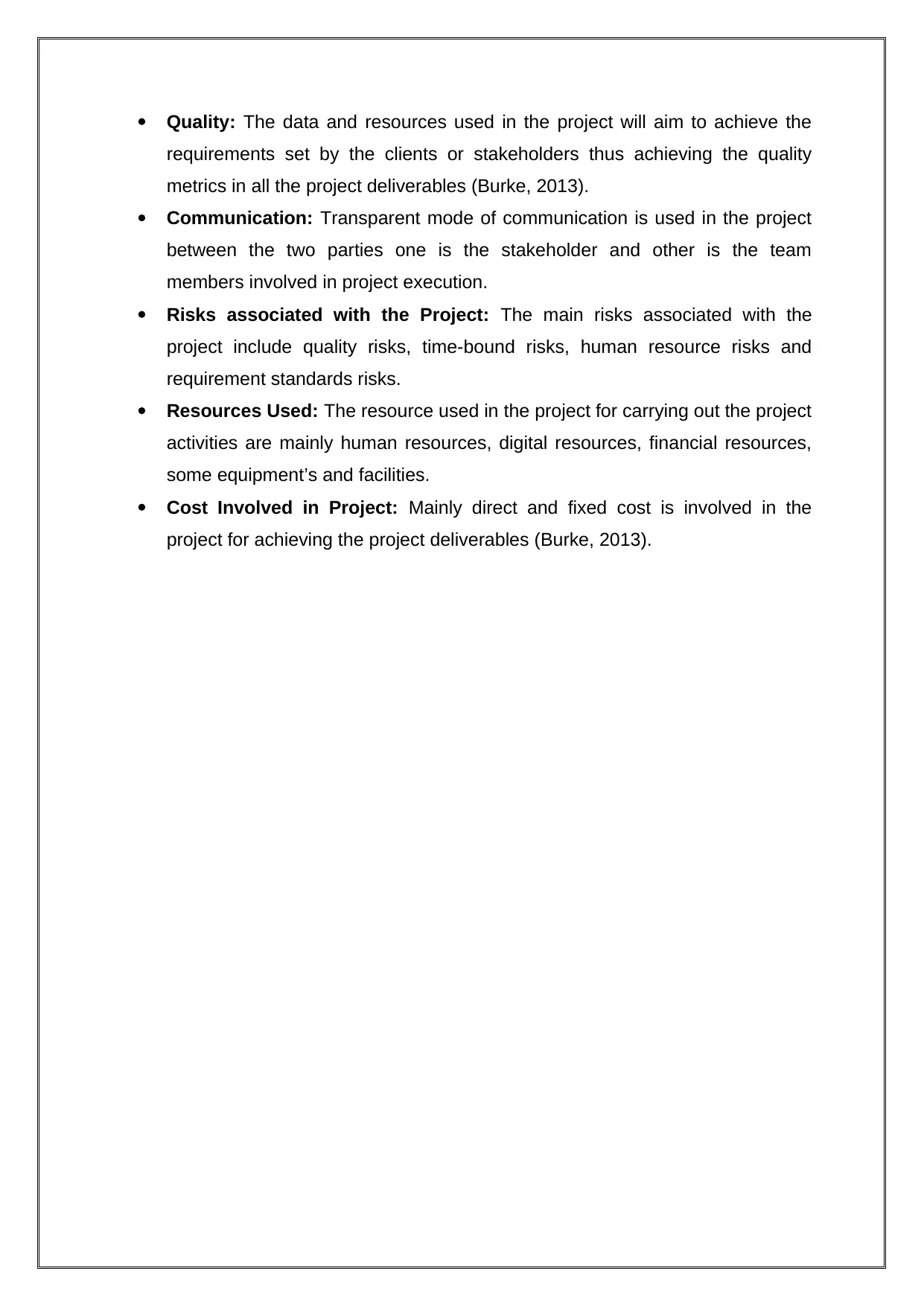
Quality: The data and resources used in the project will aim to achieve the
requirements set by the clients or stakeholders thus achieving the quality
metrics in all the project deliverables (Burke, 2013).
Communication: Transparent mode of communication is used in the project
between the two parties one is the stakeholder and other is the team
members involved in project execution.
Risks associated with the Project: The main risks associated with the
project include quality risks, time-bound risks, human resource risks and
requirement standards risks.
Resources Used: The resource used in the project for carrying out the project
activities are mainly human resources, digital resources, financial resources,
some equipment’s and facilities.
Cost Involved in Project: Mainly direct and fixed cost is involved in the
project for achieving the project deliverables (Burke, 2013).
requirements set by the clients or stakeholders thus achieving the quality
metrics in all the project deliverables (Burke, 2013).
Communication: Transparent mode of communication is used in the project
between the two parties one is the stakeholder and other is the team
members involved in project execution.
Risks associated with the Project: The main risks associated with the
project include quality risks, time-bound risks, human resource risks and
requirement standards risks.
Resources Used: The resource used in the project for carrying out the project
activities are mainly human resources, digital resources, financial resources,
some equipment’s and facilities.
Cost Involved in Project: Mainly direct and fixed cost is involved in the
project for achieving the project deliverables (Burke, 2013).
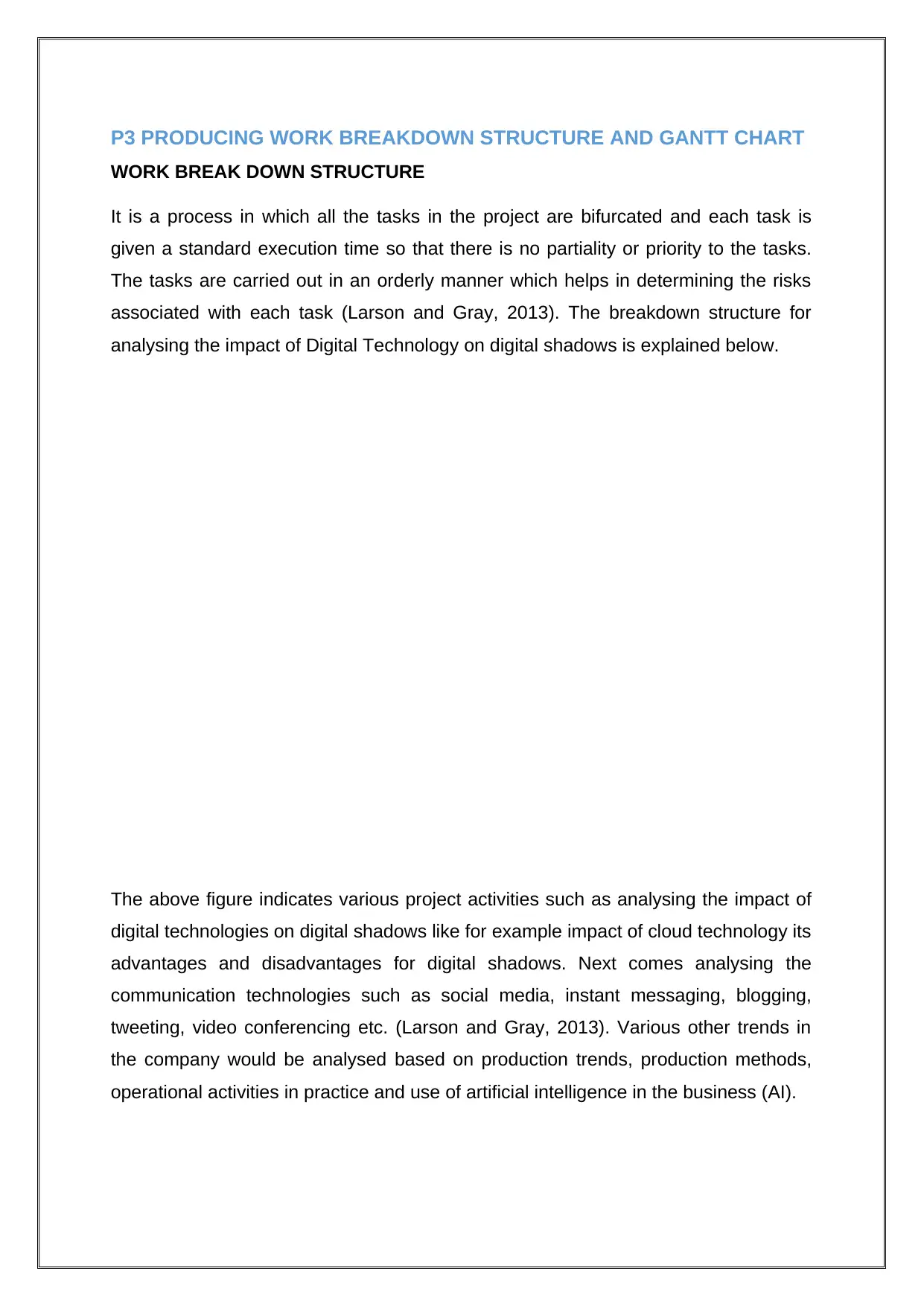
P3 PRODUCING WORK BREAKDOWN STRUCTURE AND GANTT CHART
WORK BREAK DOWN STRUCTURE
It is a process in which all the tasks in the project are bifurcated and each task is
given a standard execution time so that there is no partiality or priority to the tasks.
The tasks are carried out in an orderly manner which helps in determining the risks
associated with each task (Larson and Gray, 2013). The breakdown structure for
analysing the impact of Digital Technology on digital shadows is explained below.
The above figure indicates various project activities such as analysing the impact of
digital technologies on digital shadows like for example impact of cloud technology its
advantages and disadvantages for digital shadows. Next comes analysing the
communication technologies such as social media, instant messaging, blogging,
tweeting, video conferencing etc. (Larson and Gray, 2013). Various other trends in
the company would be analysed based on production trends, production methods,
operational activities in practice and use of artificial intelligence in the business (AI).
ProjectPlanDetermingtheimpactofDigitaltechnologiesonDigitalShadowsImpactonSalesandDistributionImpactonCommunicationImpactonOperationsImpactofDigitalDisruptiononDigitalShadowsExaminingtheimpctofDigitalTechnologiesonemployeesinDigitalShadowsAnalysingtheRisksandChallengesInvestigatingopportunituesandChallengesofDigitalTechnologies
WORK BREAK DOWN STRUCTURE
It is a process in which all the tasks in the project are bifurcated and each task is
given a standard execution time so that there is no partiality or priority to the tasks.
The tasks are carried out in an orderly manner which helps in determining the risks
associated with each task (Larson and Gray, 2013). The breakdown structure for
analysing the impact of Digital Technology on digital shadows is explained below.
The above figure indicates various project activities such as analysing the impact of
digital technologies on digital shadows like for example impact of cloud technology its
advantages and disadvantages for digital shadows. Next comes analysing the
communication technologies such as social media, instant messaging, blogging,
tweeting, video conferencing etc. (Larson and Gray, 2013). Various other trends in
the company would be analysed based on production trends, production methods,
operational activities in practice and use of artificial intelligence in the business (AI).
ProjectPlanDetermingtheimpactofDigitaltechnologiesonDigitalShadowsImpactonSalesandDistributionImpactonCommunicationImpactonOperationsImpactofDigitalDisruptiononDigitalShadowsExaminingtheimpctofDigitalTechnologiesonemployeesinDigitalShadowsAnalysingtheRisksandChallengesInvestigatingopportunituesandChallengesofDigitalTechnologies
⊘ This is a preview!⊘
Do you want full access?
Subscribe today to unlock all pages.

Trusted by 1+ million students worldwide
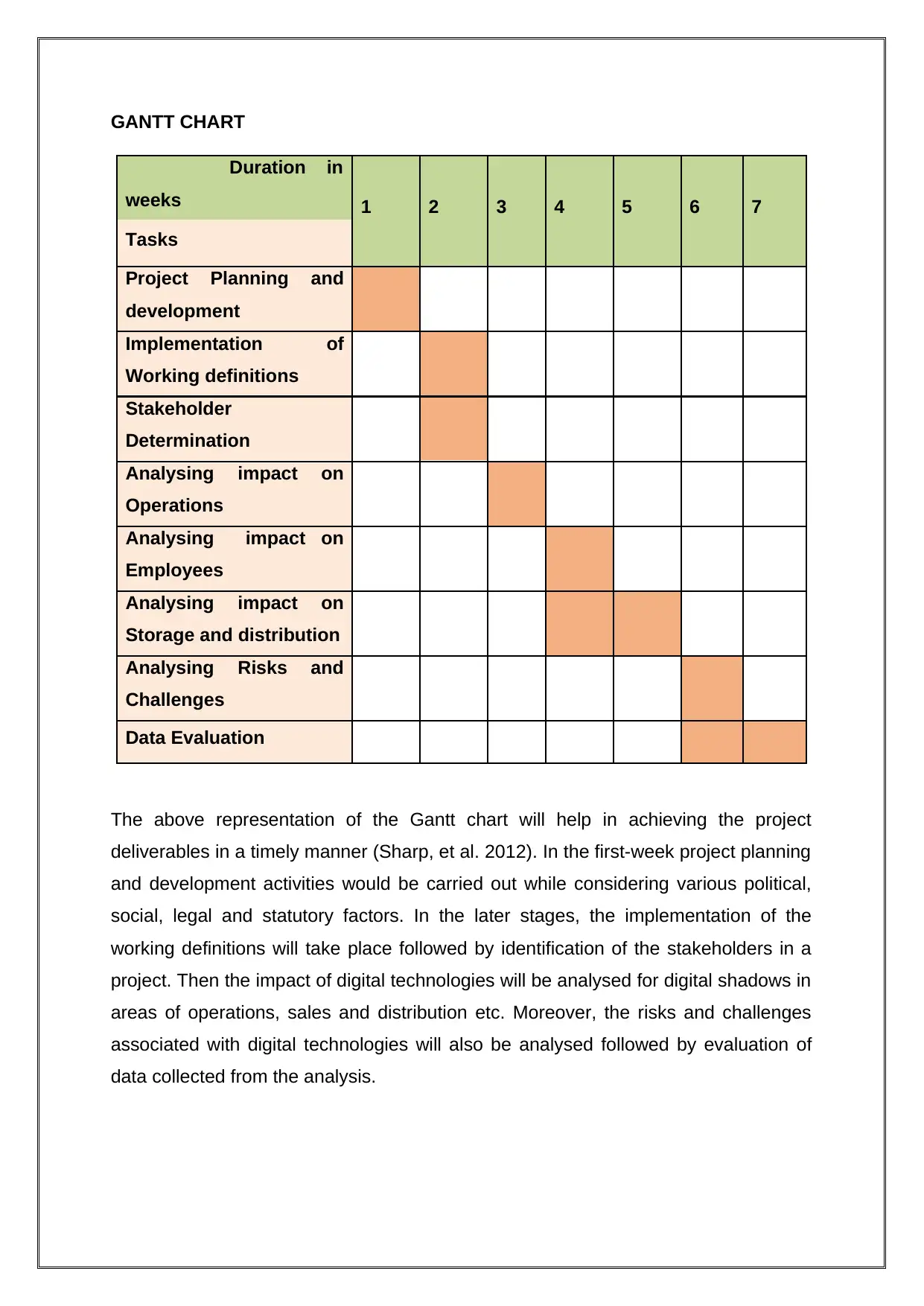
GANTT CHART
Duration in
weeks 1 2 3 4 5 6 7
Tasks
Project Planning and
development
Implementation of
Working definitions
Stakeholder
Determination
Analysing impact on
Operations
Analysing impact on
Employees
Analysing impact on
Storage and distribution
Analysing Risks and
Challenges
Data Evaluation
The above representation of the Gantt chart will help in achieving the project
deliverables in a timely manner (Sharp, et al. 2012). In the first-week project planning
and development activities would be carried out while considering various political,
social, legal and statutory factors. In the later stages, the implementation of the
working definitions will take place followed by identification of the stakeholders in a
project. Then the impact of digital technologies will be analysed for digital shadows in
areas of operations, sales and distribution etc. Moreover, the risks and challenges
associated with digital technologies will also be analysed followed by evaluation of
data collected from the analysis.
Duration in
weeks 1 2 3 4 5 6 7
Tasks
Project Planning and
development
Implementation of
Working definitions
Stakeholder
Determination
Analysing impact on
Operations
Analysing impact on
Employees
Analysing impact on
Storage and distribution
Analysing Risks and
Challenges
Data Evaluation
The above representation of the Gantt chart will help in achieving the project
deliverables in a timely manner (Sharp, et al. 2012). In the first-week project planning
and development activities would be carried out while considering various political,
social, legal and statutory factors. In the later stages, the implementation of the
working definitions will take place followed by identification of the stakeholders in a
project. Then the impact of digital technologies will be analysed for digital shadows in
areas of operations, sales and distribution etc. Moreover, the risks and challenges
associated with digital technologies will also be analysed followed by evaluation of
data collected from the analysis.
Paraphrase This Document
Need a fresh take? Get an instant paraphrase of this document with our AI Paraphraser
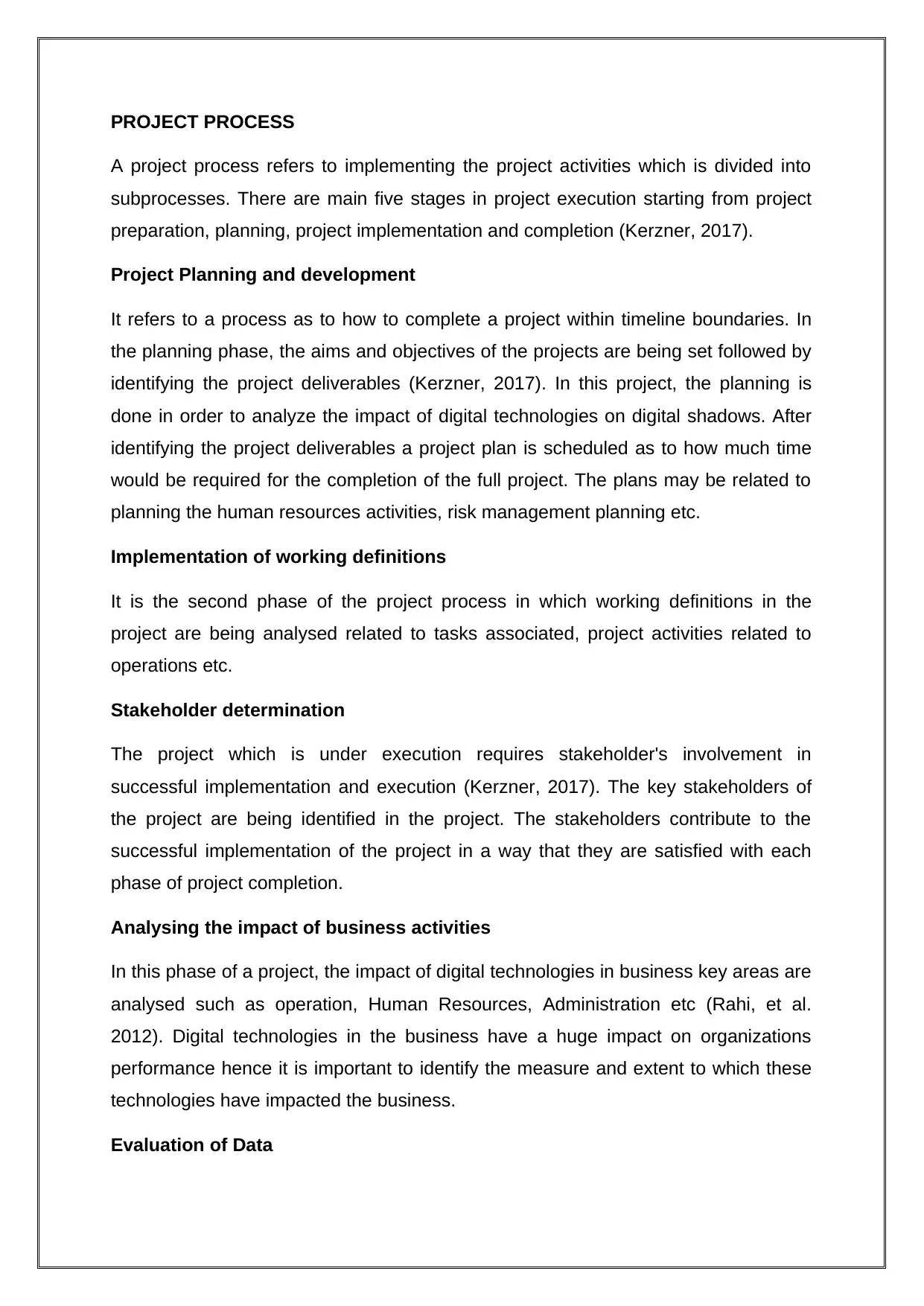
PROJECT PROCESS
A project process refers to implementing the project activities which is divided into
subprocesses. There are main five stages in project execution starting from project
preparation, planning, project implementation and completion (Kerzner, 2017).
Project Planning and development
It refers to a process as to how to complete a project within timeline boundaries. In
the planning phase, the aims and objectives of the projects are being set followed by
identifying the project deliverables (Kerzner, 2017). In this project, the planning is
done in order to analyze the impact of digital technologies on digital shadows. After
identifying the project deliverables a project plan is scheduled as to how much time
would be required for the completion of the full project. The plans may be related to
planning the human resources activities, risk management planning etc.
Implementation of working definitions
It is the second phase of the project process in which working definitions in the
project are being analysed related to tasks associated, project activities related to
operations etc.
Stakeholder determination
The project which is under execution requires stakeholder's involvement in
successful implementation and execution (Kerzner, 2017). The key stakeholders of
the project are being identified in the project. The stakeholders contribute to the
successful implementation of the project in a way that they are satisfied with each
phase of project completion.
Analysing the impact of business activities
In this phase of a project, the impact of digital technologies in business key areas are
analysed such as operation, Human Resources, Administration etc (Rahi, et al.
2012). Digital technologies in the business have a huge impact on organizations
performance hence it is important to identify the measure and extent to which these
technologies have impacted the business.
Evaluation of Data
A project process refers to implementing the project activities which is divided into
subprocesses. There are main five stages in project execution starting from project
preparation, planning, project implementation and completion (Kerzner, 2017).
Project Planning and development
It refers to a process as to how to complete a project within timeline boundaries. In
the planning phase, the aims and objectives of the projects are being set followed by
identifying the project deliverables (Kerzner, 2017). In this project, the planning is
done in order to analyze the impact of digital technologies on digital shadows. After
identifying the project deliverables a project plan is scheduled as to how much time
would be required for the completion of the full project. The plans may be related to
planning the human resources activities, risk management planning etc.
Implementation of working definitions
It is the second phase of the project process in which working definitions in the
project are being analysed related to tasks associated, project activities related to
operations etc.
Stakeholder determination
The project which is under execution requires stakeholder's involvement in
successful implementation and execution (Kerzner, 2017). The key stakeholders of
the project are being identified in the project. The stakeholders contribute to the
successful implementation of the project in a way that they are satisfied with each
phase of project completion.
Analysing the impact of business activities
In this phase of a project, the impact of digital technologies in business key areas are
analysed such as operation, Human Resources, Administration etc (Rahi, et al.
2012). Digital technologies in the business have a huge impact on organizations
performance hence it is important to identify the measure and extent to which these
technologies have impacted the business.
Evaluation of Data
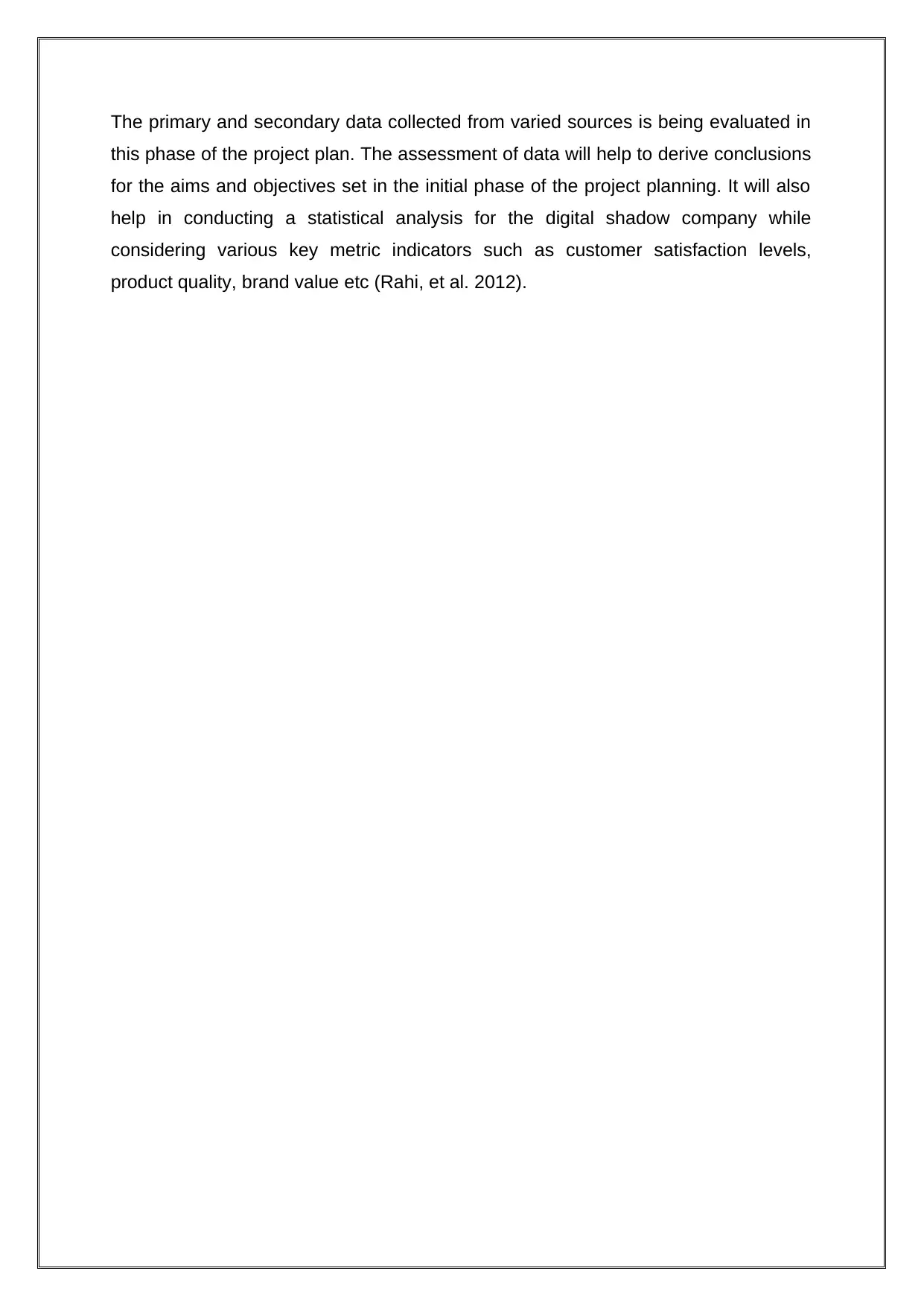
The primary and secondary data collected from varied sources is being evaluated in
this phase of the project plan. The assessment of data will help to derive conclusions
for the aims and objectives set in the initial phase of the project planning. It will also
help in conducting a statistical analysis for the digital shadow company while
considering various key metric indicators such as customer satisfaction levels,
product quality, brand value etc (Rahi, et al. 2012).
this phase of the project plan. The assessment of data will help to derive conclusions
for the aims and objectives set in the initial phase of the project planning. It will also
help in conducting a statistical analysis for the digital shadow company while
considering various key metric indicators such as customer satisfaction levels,
product quality, brand value etc (Rahi, et al. 2012).
⊘ This is a preview!⊘
Do you want full access?
Subscribe today to unlock all pages.

Trusted by 1+ million students worldwide
1 out of 22
Related Documents
Your All-in-One AI-Powered Toolkit for Academic Success.
+13062052269
info@desklib.com
Available 24*7 on WhatsApp / Email
![[object Object]](/_next/static/media/star-bottom.7253800d.svg)
Unlock your academic potential
Copyright © 2020–2025 A2Z Services. All Rights Reserved. Developed and managed by ZUCOL.





